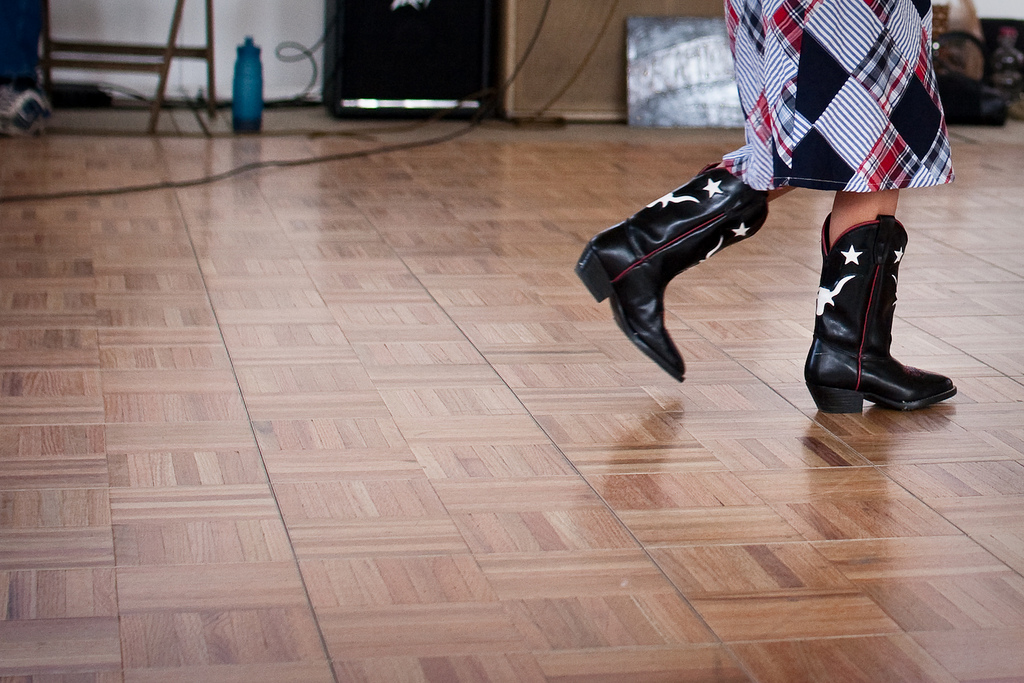
My favorite moment in a square dance usually comes at the end—dozens, sometimes hundreds of strangers, standing in a circle, holding hands, smiling, laughing, and—gasp!—talking to each other.
In a world where we spend our time staring at cellphones instead of looking into each other’s eyes, and often consider strangers mere inconveniences, it is a rare, welcome moment. So whenever I’m feeling lost and stressed in this overwhelming, sprawling metropolis, I know that the antidote will be a night of square dancing.
There’s a reason that most cultures, for most of history, have engaged in community dancing. It’s a ritual that connects us. Scientists who’ve done studies on such matters will tell you that the mixture of music, physical movement, and shared experience enhances our sense of well-being and belonging. And, oh yeah, pardon the clinical terminology, but it’s a helluva lot of fun.
When I tell people that I love to square dance, they either have no idea what I’m talking about or have terrible flashbacks to when they were in fourth grade, surrounded by sweaty, smelly kids, and wishing they were playing capture-the-flag instead of dancing with that guy who picks his nose too much. Back then, square dancing was boring and gross … just like reading, and dating, and beer, and coffee, and everything else that we weren’t smart enough to enjoy when we were younger. The vibe at a square dance is the opposite of those clammy gyms full of unhappy children—it feels more like a great wedding party.
Square dancing is a communal American folk dance based on an amalgam of European dance forms, set to old-time music (think of the soundtrack to O Brother Where Art Thou). There’s a live band, and a caller who continuously yells out instructions. Four couples are arranged in a square, with one couple on each side (though there are certain dances that involve the entire room, or groups of two couples instead of four). You have a partner for each dance, though the caller will sometimes instruct you to dance with other folks. Finding a new guy or gal to cut a rug with between dances is standard.
If that sounds at all confusing, trust me, it’s not. Social square dancing is meant to be easy. It’s the perfect kind of dancing for people who think they hate to dance—there is no skill involved, you don’t have to memorize anything, and it’s even more fun when you mess up. It’s not about proving how sexy you are, or how smooth of a dancer you are, or trying to grind up on some poor unsuspecting stranger. It’s about sharing in a good time with a bunch of other people.
Thankfully, and perhaps surprisingly, there is a burgeoning square dancing scene in L.A., which is largely associated with the band Triple Chicken Foot. They play square dances around town, about once a month or so. The crowd is generally young, fun, and drinking beer, though there are usually enough kids and badass older folk running around to make things interesting. The venues tend to be in or around Echo Park—places like Eagle Rock’s Center for the Arts, HM157 in Lincoln Heights, and the occasional local music festival. And for 10 bucks or less, with beer prices cheaper than your normal L.A. bar, it’s a huge bang for the entertainment buck. And it’s good for your soul, too.
We all need a way to shove aside the disconnectedness and distractions of our too-cluttered lives, to take a deep breath, and remember what it’s like to be fully present, fully human, fully alive, and fully connected to our fellow humans through these silly, sacred, square dances.




Send A Letter To the Editors